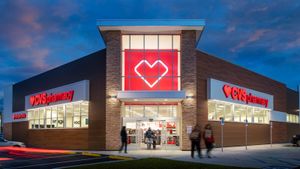Quick commerce is making waves across India, as consumers increasingly flock to online platforms for their everyday grocery needs. This rapid evolution reflects not only changing shopping preferences but also the dynamic nature of the country's retail environment during festive celebrations.
According to the latest findings from NielsenIQ (NIQ), 31 percent of Indian shoppers now rely on quick commerce as their primary grocery channel, with another 39 percent utilizing it for top-up purchases. This significant shift showcases not just consumer demand for speed and convenience but marks quick commerce's rise to mainstream grocery shopping.
Historically rooted as a service aimed at time-starved urbanites, quick commerce has fundamentally reshaped how consumers fulfill their grocery needs. Mitesh Dabrai, from NIQ, stated the doubling of quick commerce usage over the past year signifies its relevance to modern shoppers, who now prioritize being discerning, price-conscious, and channel-agnostic.
The Driving Forces Behind Quick Commerce
Rising food prices are one of the key factors pushing Indian consumers toward quick commerce. With 87 percent of respondents expressing concern about inflation affecting food prices, shoppers are showing increased price sensitivity. Still, their need for convenience remains unabated. Many consumers are becoming more strategic, balancing affordability with the growing preference for efficient shopping experiences.
Quick commerce effectively addresses this dual need by providing small-basket shopping options and frequent top-ups, allowing consumers to purchase what they need without feeling overextended. The popularity of Ready-to-Eat meals and Salty Snacks has particularly surged, with 42 percent and 45 percent of shoppers respectively turning to this channel to satisfy their cravings.
Shifting Shopping Habits
The NIQ report unveils another telling trend: consumers are increasingly adopting multichannel shopping strategies. Approximately 20 percent of offline shoppers have moved to using online platforms for their grocery needs. Interestingly, metropolitan shoppers are utilizing quick commerce for their primary grocery purchases, whereas those from non-metro areas are leaning on it for top-ups.
This adaptation indicates the emergence of versatile consumers who switch seamlessly between offline and online channels based on their needs, availability, and time constraints. Today, e-commerce platforms are being embraced for comprehensive monthly shopping trips, especially in urban areas where delivery infrastructure is well-established. Notably, 60 percent of shoppers have utilized online channels for staple groceries.
Price Sensitivity and Promotions
With the growth of quick commerce, shoppers are also becoming more discerning when it involves promotions and specials. The report highlights Modern Trade as significant, with 40 percent of shoppers willing to change stores based on offers. Interestingly, shopping impulsively is largely led by Modern Trade and online channels, at 47 percent and 35 percent respectively.
This heightened price sensitivity across all demographics due to rising inflation means shoppers are actively searching for more value-oriented propositions. For FMCG brands, it’s time to leverage this trend through strategic pricing, bundle deals, and exclusive offers. By incorporating value-driven services within the quick commerce framework—like cashback incentives and discounts—brands have the opportunity to build loyalty with consumers eager for savings and convenience.
Private Label Growth within Quick Commerce
Private labels are experiencing significant growth within the quick commerce sector, catalyzed by consumer interest in both affordable and premium alternatives. According to the NIQ findings, 67 percent of shoppers are actively pursuing premium private labels, particularly for carbonated drinks, staples, and snacks. This trend signifies the evolution of consumer preferences, as shoppers increasingly embrace non-traditional brands offering value without sacrificing quality.
Quick commerce platforms, renowned for their agile supply chains and convenience-centric nature, find themselves ideally positioned to market private label goods. Often, they feature exclusive deals on in-house brands, enhancing customer loyalty and boosting the chances of repeat purchases. For FMCG businesses, focusing on private label development, particularly products attuned to consumer preferences, can create compelling differentiators in the market.
Quick Commerce and Sustainability
Current shopping patterns also suggest growing consumer interest in sustainability. Today's shoppers are increasingly aligned with their values, longing for eco-friendly and locally sourced products. The NIQ report highlights sustainability's importance, particularly among Gen Z and Boomer shoppers, who seem more inclined toward domestically manufactured goods.
Quick commerce stands prepared to address this demand by promoting local and sustainable offerings. Retailers can significantly impact consumer preferences by ensuring easy access to groceries sourced from local suppliers and sustainable products.
The Festive Season: A Catalyst for Online Shopping
The festive season is another driving factor pushing consumers online. This year, online sales surged by 49 percent during the festive season, primarily powered by purchases from smaller Tier-II and Tier-III cities, which account for over 60 percent of online sales, as reported by ClickPost. This growth rate builds on the previous year’s impressive 39 percent increase, demonstrating the strong correlation between personal consumption and India’s economic growth.
ClickPost's comprehensive analysis gathered data from 61 million shipments across major categories like cosmetics, electronics, fashion, and home décor. Amazon's shoppers were reported to be predominantly from non-metro regions, indicating direct-to-consumer brands are now seeing greater competition against larger market players. Better internet access, promotional campaigns, and notable participation from younger, engaged shoppers are thought to facilitate these developments.
Interestingly, the Gross Merchandise Value (GMV) increased by 23 percent leading up to Diwali, primarily concentrated on electronics, fashion, and home décor—a clear illustration of consumer eagerness to invest during high-purchase periods.
Electronics reported the highest average order value (AOV) of Rs 38,000, driven by the desire for personal tech and smart home gadgets. Fashion items brought AOV to Rs 4,000, reflecting shoppers' willingness to spend on festive wardrobes, whereas investments of Rs 7,900 on home décor showed a move toward longer-lasting purchases.
The Offline vs. Online Dynamic
No-cost Equated Monthly Instalments (EMIs) fueled by financial institutions played pivotal roles. Many consumers turned to financing options within these festive platforms, with flagship phones moving swiftly off shelves because buyers often opted for models priced higher than they initially anticipated, “When someone walks to buy something valued at Rs 30,000, they tend to put their money for the variant costing Rs 45,000,” Singh noted.



